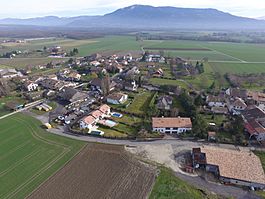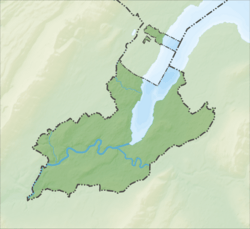Gy, Switzerland facts for kids
Quick facts for kids
Gy
|
||
|---|---|---|
 |
||
|
||
| Country | Switzerland | |
| Canton | Geneva | |
| District | n.a. | |
| Area | ||
| • Total | 3.29 km2 (1.27 sq mi) | |
| Elevation | 405 m (1,329 ft) | |
| Population
(Dec 2020 )
|
||
| • Total | 473 | |
| • Density | 143.8/km2 (372.4/sq mi) | |
| Postal code |
1251
|
|
| Surrounded by | Corsier, Jussy, Machilly (FR-74), Meinier, Veigy-Foncenex (FR-74) | |
Gy is a small town, also called a municipality, located in the Canton of Geneva in Switzerland. It's a quiet place with a rich history and beautiful natural surroundings.
Contents
History of Gy
Gy was first mentioned in old records in 1227, where it was called Gyez. Later, in 1289, its name appeared as Giez. For a long time, Gy was part of another municipality called Jussy. However, in 1851, Gy became its own independent municipality.
Geography of Gy
Gy covers an area of about 3.28 square kilometers (which is about 1.27 square miles). A big part of this land, almost 58%, is used for farming. Forests cover about 30% of the area, providing green spaces. The remaining land, about 8%, is where buildings and roads are located. A very small part, less than 2%, is unproductive land.
Most of the built-up area is made up of houses and other buildings. Roads and other transportation paths take up a smaller part. The forested areas are mostly dense, thick forests. For farming, people grow crops on about half of the agricultural land. Some areas are used for pastures where animals graze, and a small part is for growing fruits or grapes.
Gy is located on the left side of Lake Geneva. It is also on the right side of a river called the Seymaz. The municipality sits right on the border between Switzerland and France.
The municipality of Gy includes several smaller areas or villages. These are Beaupré, the main Gy village, Les Longeraies, and Les Etoiles.
Population and People in Gy
Gy has a population of about 500 people. In 2008, about 22% of the people living in Gy were foreign nationals. Over the past ten years, the population has grown by about 10%. This growth is partly because more people have moved to Gy and partly because more babies are born than people who pass away.
Languages Spoken in Gy
Most people in Gy speak French, which is the main language. A smaller number of people speak German, and some also speak English. There are also a few people who speak Italian.
Where People Come From
In 2000, about a quarter of the people living in Gy were born there. Many others, about 35%, were born in the same canton (Geneva). About 13% were born in other parts of Switzerland, and about 23% were born outside of Switzerland.
Age Groups in Gy
The population of Gy includes people of all ages. Children and teenagers (up to 19 years old) make up about 36% of the population. Adults (from 20 to 64 years old) make up about 53.5%. Seniors (over 64 years old) make up about 10.5% of the population.
Population Changes Over Time
The chart below shows how the population of Gy has changed over many years. You can see how the number of people living in Gy has gone up and down through history.

Foreign Residents in Gy
Gy is home to people from many different countries. Here's a look at the largest groups of foreign residents in 2013:
| Nationality | Amount | % total (population) |
|---|---|---|
| 38 | 7.6 | |
| 10 | 2.0 | |
| 9 | 1.8 | |
| 7 | 1.4 | |
| 7 | 1.4 |
Economy and Jobs in Gy
In 2010, the unemployment rate in Gy was low, at 3.1%. This means most people who wanted to work had a job.
Types of Jobs
People in Gy work in different types of jobs:
- Primary sector: This includes jobs related to nature, like agriculture (farming). In 2008, about 45 people worked in this sector, mostly in farming.
- Secondary sector: These jobs involve making things, like in factories or construction. About 17 people worked in this sector, with some in manufacturing and many in construction.
- Tertiary sector: This sector includes jobs that provide services, like shops, restaurants, or education. About 32 people worked in this sector.
Many people who live in Gy travel to other places for work. In 2000, about 127 people left Gy to work elsewhere, while 51 people came into Gy for their jobs. Most people use a private car to get to work, but some also use public transportation.
Religion in Gy
According to a census in 2000, people in Gy follow different religions. About 32% of the population were Roman Catholic. Another 26.5% belonged to the Swiss Reformed Church. There were also smaller numbers of people who were Orthodox Christians or belonged to other Christian churches. A small number of people were Jewish or Muslim. About 29% of the population said they did not belong to any church or were agnostic or atheist.
Education in Gy
Education is important in Gy. Many adults have completed advanced schooling. About 30.5% of the population finished upper secondary education, and 20% went on to higher education at a university or a specialized college.
School System
The school system in the Canton of Geneva, where Gy is located, has different levels:
- Kindergarten: Young children can attend two years of non-mandatory Kindergarten.
- Primary School: Students then attend six years of primary school.
- Secondary School: After primary school, there are three years of mandatory lower secondary school. This is followed by three to five years of optional, more advanced schools.
During the 2009-2010 school year, there were 105 students in the Gy school system. This included students in kindergarten, primary school, and lower secondary school. Some students from Gy also attended upper secondary schools or private schools.
In 2000, a few students from other towns came to school in Gy. However, more students from Gy traveled to schools outside the municipality.
See also
 In Spanish: Gy (Ginebra) para niños
In Spanish: Gy (Ginebra) para niños




